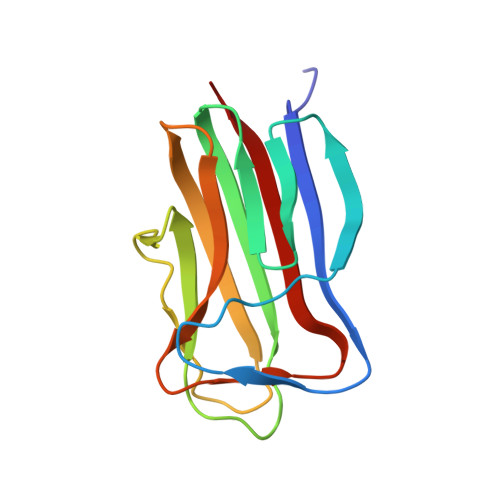Construction, crystal structure and application of a recombinant protein that lacks the collagen-like region of BclA from Bacillus anthracis spores.
Liu, C.Q., Nuttall, S.D., Tran, H., Wilkins, M., Streltsov, V.A., Alderton, M.R.(2008) Biotechnol Bioeng 99: 774-782
- PubMed: 17879302
- DOI: https://doi.org/10.1002/bit.21637
- Primary Citation of Related Structures:
2Z5W - PubMed Abstract:
Spores of Bacillus anthracis, the causative agent of anthrax, are enclosed by an exosporium, which consists of a basal layer surrounded by a nap of hair-like filaments. The major structural component of the filaments is called BclA, which comprises a central collagen-like region (CLR) and a globular C-terminal domain. Here, the entire CLR coding sequence of BclA was removed, and the resulting protein (tBclA) produced in Escherichia coli. The crystallographic structure of tBclA was determined to 1.35 A resolution, and consists of an all-beta structure with a TNF-like jelly fold topology (12 beta-strands which form 2 beta-sheets of five strands each) consistent with previous studies on wild-type BclA. These globular domains are tightly packed into trimeric structures (surface shape complementarity; S (c) = 0.83), demonstrating that formation of the core structure of BclA is independent of the anchoring collagen-like region. A polyclonal antibody raised against tBclA recognized B. anthracis spores directly, and showed little cross-reactivity (<10%) with the spores of the closely related species Bacillus cereus and Bacillus thuringiensis, when compared to two other polyclonal antibodies raised against B. anthracis spore extracts and inactivated spores. The tBclA protein was used to purify a pool of specific antibodies from bovine colostrum whey samples from cows inoculated with the Sterne strain anthrax vaccine, which also showed reactivity with B. anthracis spores. Together, these results demonstrate that tBclA provides a safer and more effective way to the production and purification of antibodies with high binding affinity for B. anthracis spores. Biotechnol. Bioeng. 2008;99: 774-782. (c) 2007 Wiley Periodicals, Inc.
Organizational Affiliation:
DSTO Human Protection & Performance Division, 506 Lorimer Street, Fishermans Bend, Melbourne, Victoria 3207, Australia. chun.liu@dsto.defence.gov.au















